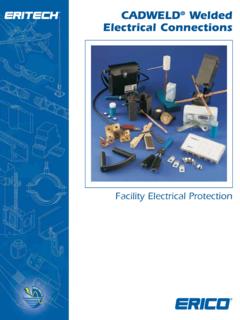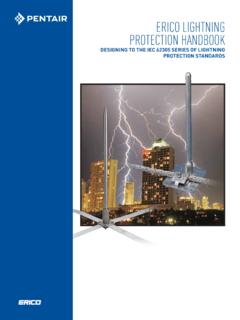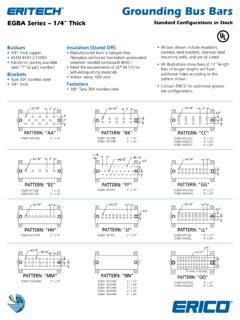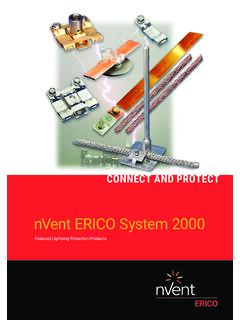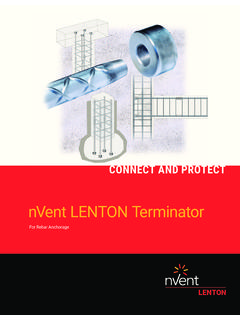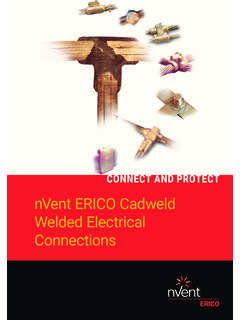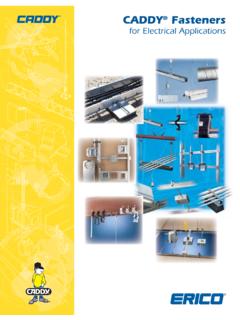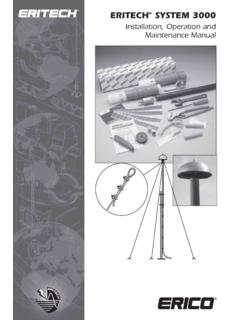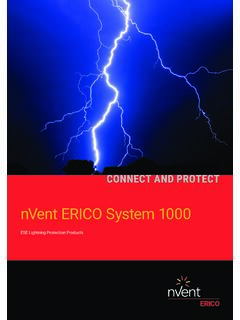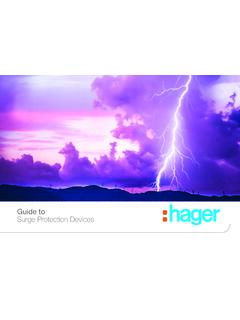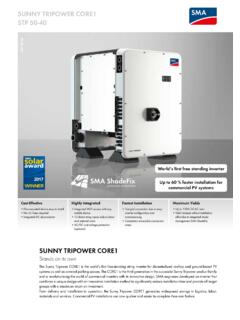Transcription of Service Entrance SPD - Selecting & Installing
1 Page 1 of 6 CRITEC Technical Note & Installing Service Entrance SPDsWarwick BeechSenior Application EngineerERICO, IncAbstract: The art of Installing an SPD is to ensure compliance with relevant electrical and safetycodes while maintaining optimum performance. This document provides installation examples,"rules of thumb and discussion of related industry first line of defense in protecting a facility fromexternally created electrical surges is the SurgeProtection Device (SPD) installed at the main serviceentrance. The term SPD is a generic description definedby the IEC. Within the USA SPDs are furthercategorized as:- the Transient Voltage surge Suppresser(TVSS) and the Secondary surge Arrester.
2 In accordancewith UL 1449 listing requirements, a TVSS device mustbe installed on the load side of the main over-currentprotection. The role of Secondary surge Arresters,which are intended for installation on the line side ofthe main over-current protection, are discussed Standard Electrical PanelsMost TVSS s available on the market are self-containedand designed to be installed next to the electrical panelboard via a short direct nipple connection to the panel asshown in Figure 1. Integrated Panels where the TVSSis installed inside the panel are becoming more advantages and shortcomings of these speciallyapproved Integrated Panels are discussed 1. Optimal SPD requires the TVSS to be connected on the load sideof the main over-current device.
3 When connecting thisexternal TVSS to a typical compact electrical panel, it isoften not possible to access the bus between the mainover-current device and the sub-feed/branch circuitbreakers. The TVSS is designed to be connected to the first sub-feed circuit breaker ( the breaker closest tothe main over-current protective device).Most TVSS s are supplied with flying leads for quickconnection to the sub-feed circuit breaker. The TVSS'sinstructions will list the ampacity requirements of thebreaker to which it should be connected. The connectionlead length has an important effect on the performance ofthe protection system and will be discussed more fullylater in this document. The optimal installation is todirect nipple mount the TVSS to the outside of theelectrical panel next to the circuit breaker to which it isto be larger TVSS s are supplied with internal terminalsinstead of flying leads, thus allowing the installer toselect the interconnecting wire size.
4 Although the wiringto the TVSS carries negligible load current (prior to thepresence of a surge ), it is normal practice to select thecircuit breaker amperage based on the conductor scurrent carrying ability. If given a choice, utilize thelargest wire size as this provides a small improvement inthe let-through voltage performance. More importantly,it allows a larger circuit breaker size to be used,potentially increasing the maximum surge current ratingthat the system can protect against. A large surge may beseen by the circuit breaker as a 50/60Hz short circuitcurrent causing it to trip, taking the TVSS offline. Alarger rated circuit breaker is less likely to trip.
5 Forexample, a 30A breaker will typically trip on a surgecurrent of 15-25kA 8/20 s while a 50A breaker willincrease this to 20-60kA 8/20 in mind that while 50% of all direct lightningstrikes are greater than 30kA in peak amplitude, only 2%exceed 120kA. A direct strike to a power line is rare, andin most cases only 25% of this discharge energy reachesthe Service Entrance . Although SPD vendors makedevices with surge ratings of hundreds of kA, Installing acircuit breaker larger than 50A only offers a very smallimprovement in the statistical protection provided, whileShort direct connectionPage 2 of 6 CRITEC Technical Note the risk of not being able to quickly interruptan electrical short circuit during fault convenience of using a sub-feed circuit breaker tomake connection to the TVSS also provides an importantadvantage.
6 It allows the TVSS unit to be isolated duringmaintenance, while the primary supply to the facility isstill is important to adhere to the manufacturer srecommendations on wiring size and fusing requirementsas these are generally based on UL s conditions of use for the particular device s Custom Designed PanelsFor larger custom-designed panels it is often possible toconnect the TVSS device between the load side of themain over-current protection and the sub-feed breakerspanel. This requires a T , or tap connection, to be madefrom the bus to the Entrance PanelSecondarySurgeArresterTVSSTVSSTVSSS ource* NEC 240-21 Applies(Circuit Breaker)Main over-currentprotective device*Feeder/branchcircuitsFigure 2. Possible SPD connectionsTo meet relevant electrical and wiring codes, the TVSS unit is generally installed along side of the electricalpanel via a conduit nipple connection.
7 The location ofthe TVSS unit in relation to its connection to the panel,should be selected to minimize the length of theinterconnecting wiring. This will improve performanceduring a surge NEC tap rule allows for a smaller tap wire to berun from the larger bus to the TVSS. In keeping with thedesire to minimize the length of this connection, the 10 tap rule Article 240-21 generally applies. A tapconnection can only be made where the current rating ofthe tap connection to the TVSS is greater than 1/10 ofthe upstream over-current device s rating. For example,assume the maximum wire size which a manufacturerspecifies can be connected to the terminals of his TVSS device is #3.
8 Reference to Table 310-16 indicates thatthis can carry a current rating of 80A. Then by applyingthe NEC tap rule, we see that the TVSS unit can only bedirectly connected where the Service Entrance is limitedby an 800A over-current rating. Note: Although suchtap connectors are not generally regarded as loadcurrent carrying, it is normal practice to assume thatthey are when sizing to conform to the upstream over-current protection. It is often easier to do this than toexplain to installers/inspectors the apparent mismatchin conductor / over-current protection device Installing a TVSS device on Service entrancepanels with large current ratings the 1/10 taprequirement may mean that the correct tap conductor sizeexceeds the capacity of the TVSS s terminals.
9 Undersuch conditions, a circuit breaker is usually required atthe point at which the tap conductor connects to theprimary supply. The size of this breaker should be chosento accommodate the size of the tap conductor such a measure provides safety and compliancewith the tap rule, it also add cost, complexity, and theintroduction of extra series components which mayincrease the let-through voltage, and which may alsolimit the peak surge rating of the avoid these performance issues, the user needs toovercome the 1/10 restrictions of Article 240-21 ( ) ..field installation where the tap conductors leave theenclosure or vault in which the tap is :1. Some TVSS vendors argue that by Installing theTVSS on the outside of the enclosure and utilizing adirect nipple connection into the enclosure, the 1/10requirement does not apply as the wiring does notleave the enclosure rather, the TVSS wires areregarded as entering into the enclosure.
10 Whilst itmay be argued that this allows the installer a loophole which can be exploited, the intent of the NECtap rule is clear to limit under-rated tapconductors being connected to large current Some TVSS vendors also argue (and evendocument) that, as their TVSS s incorporate integralover-current disconnect devices , no additionalupstream over-current protection is required and theunit can be installed with small tap conductors onvery large services. The author is not aware of anyNEC Articles that specifically allow this, unless theTVSS installation is not made as part of a fieldinstallation ref. 3 of 6 CRITEC Technical Note If the installation of a TVSS unit is not carried outas part of a field exercise, as may be the case whenswitchboard builder incorporates the unit as acomponent within an electrical panel assembly,Article 240-21 ( ) is not applicable and allows the tap to be installed on any currentrated Service , provided that the tap conductors arematched to the rating of the TVSS s internal over-current than exploiting loose interpretations of the 1/10rule to avoid upstream over-current protection, it isrecommended that upstream over-current protection beprovided at the point the conductors receive theirsupply.
